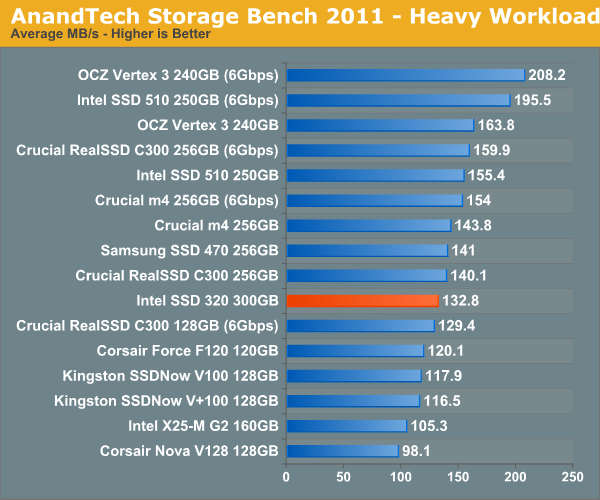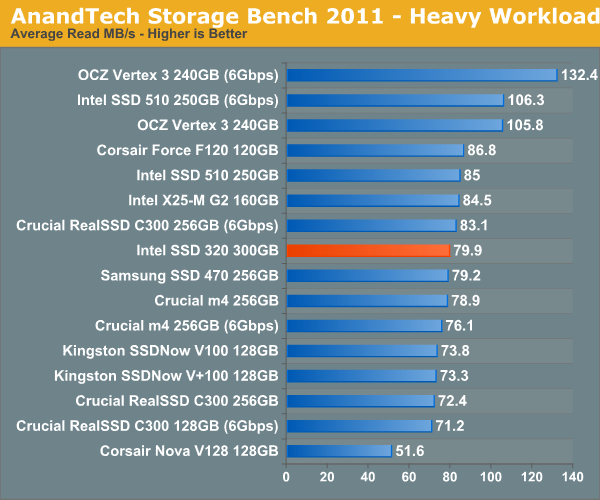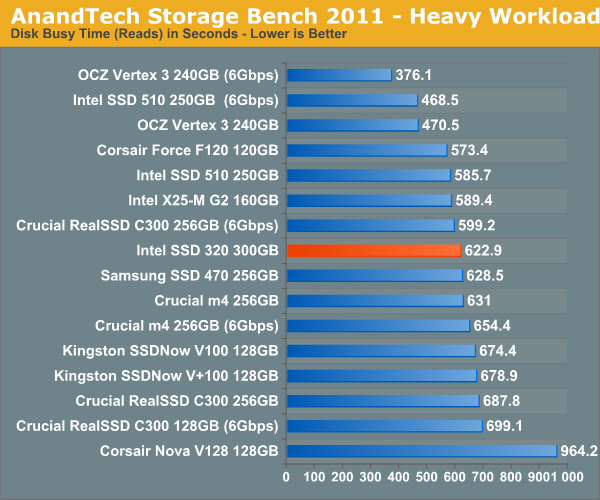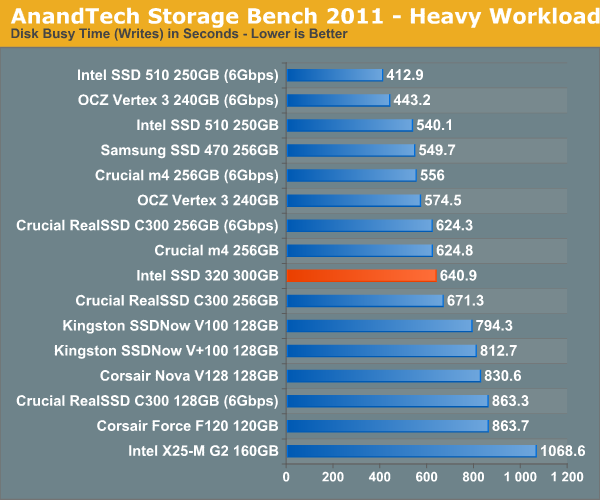The Intel SSD 320 Review: 25nm G3 is Finally Here
by Anand Lal Shimpi on March 28, 2011 11:08 AM EST- Posted in
- IT Computing
- Storage
- SSDs
- Intel
- Intel SSD 320
AnandTech Storage Bench 2011: Much Heavier
I didn't expect to have to debut this so soon, but I've been working on updated benchmarks for 2011. Last year we introduced our AnandTech Storage Bench, a suite of benchmarks that took traces of real OS/application usage and played them back in a repeatable manner. I assembled the traces myself out of frustration with the majority of what we have today in terms of SSD benchmarks.
Although the AnandTech Storage Bench tests did a good job of characterizing SSD performance, they weren't stressful enough. All of the tests performed less than 10GB of reads/writes and typically involved only 4GB of writes specifically. That's not even enough exceed the spare area on most SSDs. Most canned SSD benchmarks don't even come close to writing a single gigabyte of data, but that doesn't mean that simply writing 4GB is acceptable.
Originally I kept the benchmarks short enough that they wouldn't be a burden to run (~30 minutes) but long enough that they were representative of what a power user might do with their system.
Not too long ago I tweeted that I had created what I referred to as the Mother of All SSD Benchmarks (MOASB). Rather than only writing 4GB of data to the drive, this benchmark writes 106.32GB. It's the load you'd put on a drive after nearly two weeks of constant usage. And it takes a *long* time to run.
I'll be sharing the full details of the benchmark in some upcoming SSD articles but here are some details:
1) The MOASB, officially called AnandTech Storage Bench 2011 - Heavy Workload, mainly focuses on the times when your I/O activity is the highest. There is a lot of downloading and application installing that happens during the course of this test. My thinking was that it's during application installs, file copies, downloading and multitasking with all of this that you can really notice performance differences between drives.
2) I tried to cover as many bases as possible with the software I incorporated into this test. There's a lot of photo editing in Photoshop, HTML editing in Dreamweaver, web browsing, game playing/level loading (Starcraft II & WoW are both a part of the test) as well as general use stuff (application installing, virus scanning). I included a large amount of email downloading, document creation and editing as well. To top it all off I even use Visual Studio 2008 to build Chromium during the test.
Many of you have asked for a better way to really characterize performance. Simply looking at IOPS doesn't really say much. As a result I'm going to be presenting Storage Bench 2011 data in a slightly different way. We'll have performance represented as Average MB/s, with higher numbers being better. At the same time I'll be reporting how long the SSD was busy while running this test. These disk busy graphs will show you exactly how much time was shaved off by using a faster drive vs. a slower one during the course of this test. Finally, I will also break out performance into reads, writes and combined. The reason I do this is to help balance out the fact that this test is unusually write intensive, which can often hide the benefits of a drive with good read performance.
There's also a new light workload for 2011. This is a far more reasonable, typical every day use case benchmark. Lots of web browsing, photo editing (but with a greater focus on photo consumption), video playback as well as some application installs and gaming. This test isn't nearly as write intensive as the MOASB but it's still multiple times more write intensive than what we were running last year.
As always I don't believe that these two benchmarks alone are enough to characterize the performance of a drive, but hopefully along with the rest of our tests they will help provide a better idea.
The testbed for Storage Bench 2011 has changed as well. We're now using a Sandy Bridge platform with full 6Gbps support for these tests. All of the older tests are still run on our X58 platform.
AnandTech Storage Bench 2011 - Heavy Workload
We'll start out by looking at average data rate throughout our new heavy workload test:

Overall performance is decidedly last generation. The 320 is within striking distance of the 510 but is slower overall in our heavy workload test.
The breakdown of reads vs. writes tells us more of what's going on:


The next three charts just represent the same data, but in a different manner. Instead of looking at average data rate, we're looking at how long the disk was busy for during this entire test. Note that disk busy time excludes any and all idles, this is just how long the SSD was busy doing something:













194 Comments
View All Comments
bji - Monday, March 28, 2011 - link
You're retarded. Their systems do 'just work' according to the promised features and reliability. Just because they don't promise TRIM support, and apparently don't require it to satisfy the performance that they promise, doesn't mean that their stuff doesn't 'just work'. The fact is that end users do not need to do any of those commands to use their SSD drives as they are intended to be used.Not that I should even have to say this, but I don't own a single piece of Apple hardware aside from an old iPod Touch. So please don't accuse me of being a fanboy just because I can't stand ridiculous criticisms like yours. I would defend any company against such drivel.
Vidmar - Monday, March 28, 2011 - link
Wait a minute..."Their systems do 'just work' according to the promised features and reliability."
and
"I don't own a single piece of Apple hardware aside from an old iPod Touch"
So how can you quantify the first statement if you don't own any?
bji - Monday, March 28, 2011 - link
So how many Apple devices do I have to own before I can say whether or not they 'just work'? 10? 100? A million? All of them?Obviously there is no answer to that question that makes any sense; because the question doesn't make any sense.
I was not talking about the actual fact of whether or not any particular Apple device 'just works', I was talking about the question of whether or not the claim that Apple products 'just work' is an any way refuted by the original poster's dumb post. I don't need to ever have touched an Apple product to be able to argue about how those comments did not refute any of the claims that Apple may make directly or indirectly about their products.
Here is a simplified example if this is too hard for you to follow:
Poster A: Look at these instructions on how to replace the heating elements of my toaster with a miniature nuclear reactor core! The are so long and complicated! I can't believe that my toaster manufacturer claimed that this toaster was easy to use!!!
Me: That's dumb, the manufacturer never claimed that installing aftermarket parts on your toaster would be easy; that has nothing to do with the ease-of-use of a toaster. By the way I do own an electric razor made by your toaster company but that doesn't mean I'm biased towards them.
You: How do you know whether or not his toaster is really easy to use if you don't own one?
B3an - Tuesday, March 29, 2011 - link
You call me a retard, yet you dont even have ANY first hand experience with OSX.I think you're the retard here.
It's not just about TRIM, it's with many things about Apple products. Hardware and software. All Apple do is falsely advertise and claim that everything they make just works, and is immune to viruses, even though OSX is the most unsecure major OS around.
It can also be argued that if Apple are going to use SSD's in there products, then they should atleast fully support TRIM, which is something that is needed for an SSD to perform at it's best.
sean.crees - Tuesday, March 29, 2011 - link
They do fully support TRIM. For SSD's that ship with their products. This isn't just an SSD thing though, they have always been this way with hardware, only fully supporting hardware that they personally sell. It does have it's advantages though. You may not personally like it, but Apples approach to hardware and software does have its advantages over the way it's done in the PC world.marraco - Tuesday, March 29, 2011 - link
Apple pretends to be user friendlier than Windows, yet each non basic troubleshooting ever takes a boatload of console commands, hex editors, rebooting into console mode, and crap like it.Brian Klug - Monday, March 28, 2011 - link
I've taken the plunge and am running TRIM (via the hex-edited kext) on my 2011 MBP with Vertex 2. If this drive randomly implodes, I'm sure someone will get a stern emailing about it ;)-Brian
Anand Lal Shimpi - Monday, March 28, 2011 - link
I think there's a lot of misunderstanding about what TRIM really does. TRIM simply passes information to the controller - it just says "hey controller, I don't need these LBAs anymore so you can do what you will with them".The controller then chooses what to do with those LBAs given its internal policies.
The alternative would be to use aggressive idle time garbage collection. I'm not personally a fan of this as it does burn up p/e cycles vs. more conservatively running through garbage collection routines when necessary.
TRIM really does help keep performance high. Until we get filesystems that are NAND-aware, it's the best option we have.
Take care,
Anand
bji - Monday, March 28, 2011 - link
What is a filesystem that is 'NAND-aware' other than one that knows how to tell the underlying device that it's done with a block, i.e., issue a TRIM command?jcompagner - Tuesday, March 29, 2011 - link
Then please tell me,if trim didn't tell the ssd that it doesn't need that block, what can garbage collect do then?
So i write the drive completely full. then i delete half of it without trim.
Now i don't do anything, what can then a GC do? Nothing.. because as far as the ssd concern everything is still valid real data.
Only when i then start writing on places where the ssd thought that was written it knows that it can write there again..
If you keep your trash out of the the garbage bin then you can empty your bin all the time you want but the garbage is not cleared.